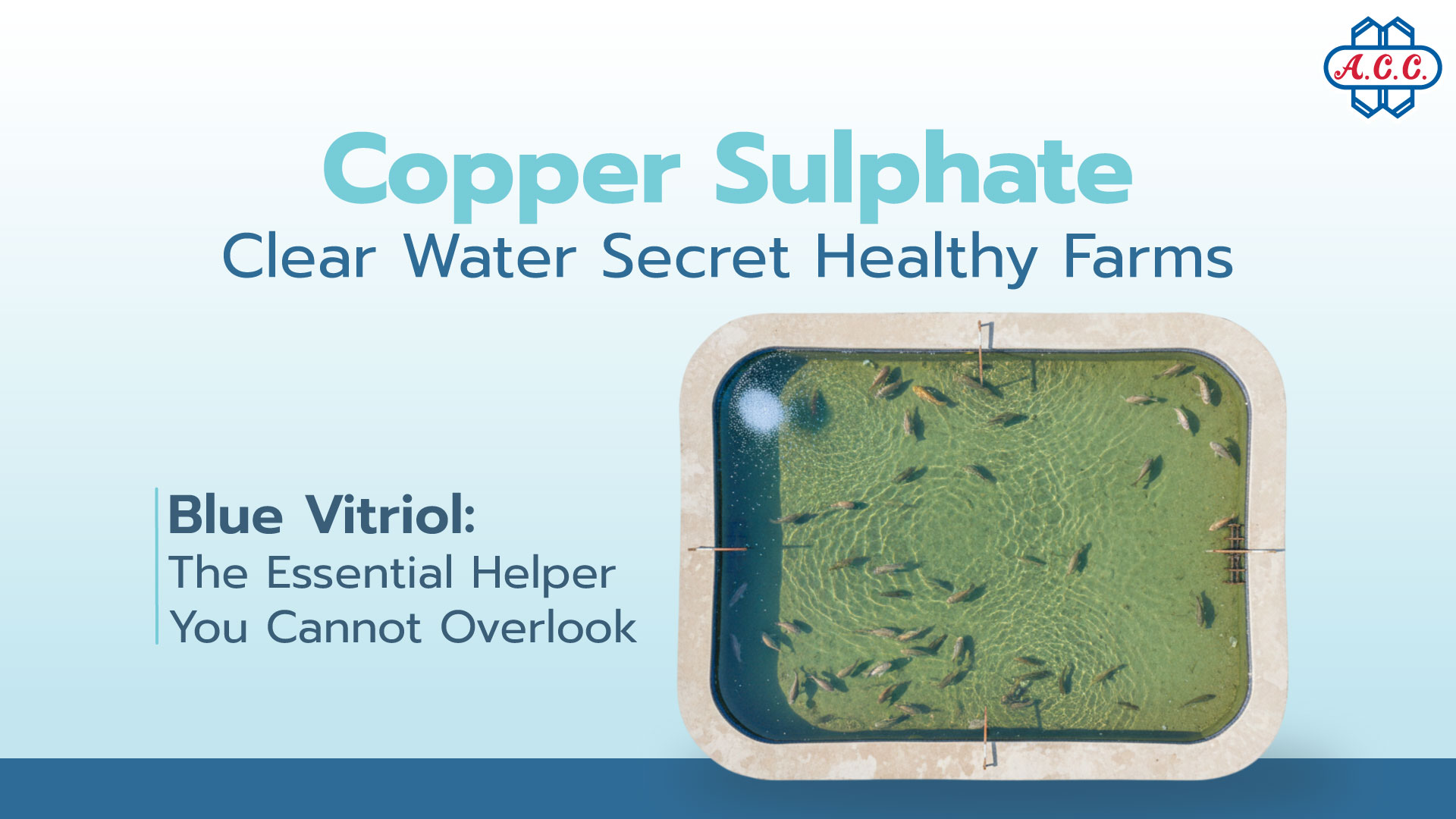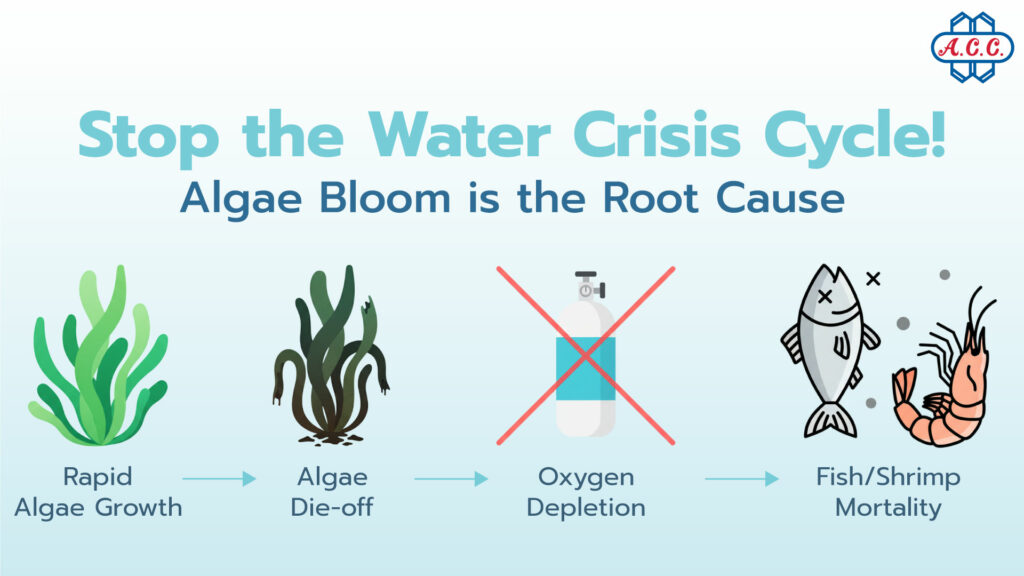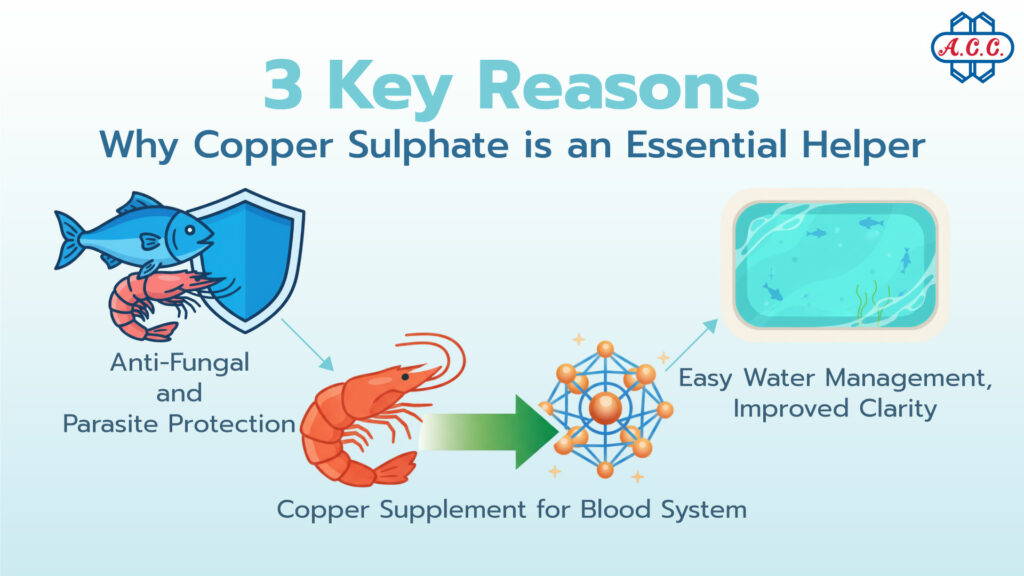
15 Oct Copper Sulphate: A Crucial Helper in Water Systems and Aquaculture Farms
Have you ever wondered what the secret is behind the pristine clarity of large fish and shrimp ponds, which significantly contributes to the healthy growth of aquatic animals and reduces mortality rates? Many might overlook the bright blue chemical compound known as Copper Sulphate (or its common name, “Blue Vitriol”). Yet, this substance is, in fact, one of the most vital tools used in the aquaculture industry for water quality control, offering far more benefits than mere algae removal.
Imbalanced Water Systems: The Hidden Problem in Ponds
For operators of fish farms, shrimp farms, or water treatment system managers, maintaining water quality is the heart of the operation. Ponds that appear calm and normal from the outside may actually be facing an unseen threat: the excessive growth of algae (Algae Bloom) and the accumulation of bacteria or various parasites.
When certain types of algae multiply rapidly (Algae Bloom), it causes severe fluctuations in the water’s pH level between day and night. Furthermore, as these algae die off, their decomposition consumes a vast amount of dissolved oxygen (Oxygen Depletion), which is the primary reason fish or shrimp can suffer shock and die en masse. Additionally, the accumulation of undesirable bacteria and fungi is also a source of various diseases in aquatic animals, such as white spot syndrome in shrimp or gill rot.
This is precisely where Copper Sulphate steps in as a key player. This substance is not just a common chemical; it is a scientific tool that enables operators to accurately manage the biological balance within the water.

The Main Roles of Copper Sulphate in Water Systems
Copper Sulphate (CuSO4⋅5H2O), in its bright blue crystalline form, is widely utilized across many industries. However, in water systems and aquaculture, its most critical roles are serving as a highly effective algicide and antiseptic:
∘ Algae Control The outstanding property of Copper Sulphate is its ability to counteract harmful algae and small aquatic plants. The copper ions released when Copper Sulphate dissolves in water inhibit the algae’s photosynthesis process, preventing them from producing food and continuing to grow. Controlling algae at an optimal level is extremely important because it:
- Maintains Oxygen Levels: Helps prevent Algae Bloom from depleting oxygen during the night.
- Controls pH: Stabilizes the water’s acidity/alkalinity, reducing stress on aquatic animals.
- Improves Water Clarity: Enhances the efficiency of observing animal behavior and farm management.
∘ Disease and Parasite Management In the aquaculture industry, Copper Sulphate is also an essential component used in treating external diseases (External Parasites) affecting aquatic animals, specifically for:
- Killing External Parasites: It is used to eliminate certain parasites that cling to fish or shrimp, which are causes of illness and disease outbreaks.
- Fungal Resistance: It is employed to prevent and treat diseases caused by fungi in fish, such as those resulting from unclean water or wounds.
∘ Copper Supplementation Beyond its antimicrobial role, the element Copper is also an essential trace element for the growth of aquatic animals, particularly shrimp and crabs. This is because copper is a key component in the creation of Hemocyanin, the substance responsible for oxygen transport in the blood of crustaceans and mollusks, similar to hemoglobin in humans. Therefore, the careful use of small amounts of Copper Sulphate can also supplement copper in the animal’s diet, resulting in healthier aquatic animals and higher survival rates.

Advantages of Using Copper Sulphate Correctly
Compared to other chemical agents, Copper Sulphate has distinct advantages that have led to its widespread acceptance:
∘ Accuracy in Control Copper Sulphate is a compound with a stable chemical formula. This allows users to accurately calculate the required dosage based on the pond size and the optimal concentration needed to eliminate pathogens or algae, without concerns over ingredient fluctuations.
∘ Efficiency and Cost Due to its fast and broad-spectrum action, Copper Sulphate is highly efficient in managing water pollution and algae problems over large areas. This makes it a cost-effective choice for industrial farms.
∘ Compatibility in Water Treatment Systems Copper Sulphate is also utilized in closed-loop wastewater treatment systems to help reduce heavy metal ions and control certain bacteria before subsequent treatment stages, making it an indispensable part of the overall environmental management process.
Precautions and Guidelines for Safe Use
While Copper Sulphate has immense benefits, safety in its application must be the top priority. This is because, if used in excessive amounts, it becomes toxic to aquatic life, particularly animals highly sensitive to copper, such as shrimp and mollusks.
∘ Recommended Practices
-
Know the Water’s Alkalinity:
This is crucial! The safe amount of Copper Sulphate for aquatic life depends on the pond water’s alkalinity value. The higher the alkalinity (more basic water), the more safely you can use a higher concentration of Copper Sulphate. If the water has low acidity or alkalinity (low alkalinity value), the substance must be used in very small amounts to prevent toxicity to the aquatic animals. (Reference: Most research indicates that a low alkalinity value, specifically below 50 mg/L, warrants extreme caution when using Copper Sulphate).
-
Dosage Testing:
Always start by using the lowest concentration possible and regularly test the amount of algae or pathogens in the water to ensure only the “necessary” amount is used.
-
Proper Dissolution:
Ensure that the Copper Sulphate dissolves well and is evenly distributed throughout the pond to prevent the formation of highly concentrated spots (Hotspots) that could be harmful to aquatic animals that come into direct contact.
-
Personal Protection:
Operators should wear gloves and protective equipment to avoid direct contact with skin and eyes, adhering to chemical safety principles.
Therefore, using Copper Sulphate is not just about adding a substance to a pond; it is about the principled and responsible chemical management of water, accountable to both the aquatic life and the environment.
Conclusion
Copper Sulphate, in its form as the beautiful blue crystal, Blue Vitriol, has proven to be a valuable compound that is far more versatile and complex than commonly perceived. In the aquaculture and water management industries, this substance serves as a critical balancer, from controlling algae that could lead to an oxygen crisis to being an essential trace element for aquatic animal health.
By using it with knowledge, understanding of water chemistry principles, and strict adherence to safety standards, Copper Sulphate will remain an indispensable tool for driving these industries towards a sustainable and efficient future.
High-Quality Copper Sulphate for Your Industry’s Sustainable Success
As a leader in the manufacturing and distribution of copper compounds (Copper Sulphate) and wastewater treatment chemicals (Ferric Chloride), Asian Chemical Co., Ltd. (ACC) is committed to delivering the highest quality products. Our commitment is backed by international certifications such as ISO 9001, 14001, 45001, FAMI-QS, and HACCP, ensuring that our customers in the aquaculture industry receive chemical products that are safe and highly effective.
📞 Tel: +66 (38) 570 150-2 Ext. 106, 107 or +66 (81) 8337 043
📩 E-mail: [email protected]
🌐 Website: https://acc1976.com/th/
🏢 Asian Chemical Co., Ltd.
85/1 Moo 5, Wellgrow Industrial Estate, Bangna-Trad Rd. Km.36, Bang Samak, Bang Pakong, Chachoengsao 24130, Thailand.



No Comments